|
Being situated in a natural amphitheatre on rolling meadow land, the racing at Brands Hatch was for 'bikes', bicycles. It was also used for pacing contests. By 1928, the other type of 'bikes', motor cycles, were racing on the grass track. Prior to the World War II, Brands Hatch was the best known motor cycle grass track in Britain. One of its stars was Jack Surtees, the father of John Surtees.
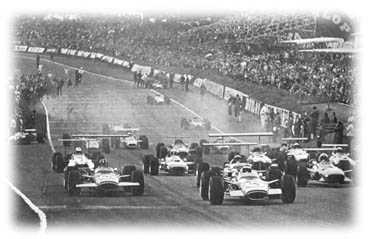 In late 1949, Brands Hatch held its last grass track race. The 2 km circuit was paved and held its first event for racing cars that Spring. On April 16th, 1950, the Half Litre Car Club sponsored a race for the popular 500cc Formula Three cars. Stirling Moss finished sixth in his Cooper in that event. By the end of the season, five more races were held for the highly popular 500cc cars. Brands was a very popular venue for Formula Three during its heyday. In late 1949, Brands Hatch held its last grass track race. The 2 km circuit was paved and held its first event for racing cars that Spring. On April 16th, 1950, the Half Litre Car Club sponsored a race for the popular 500cc Formula Three cars. Stirling Moss finished sixth in his Cooper in that event. By the end of the season, five more races were held for the highly popular 500cc cars. Brands was a very popular venue for Formula Three during its heyday.
The first victory for the only World Champion on both two and four wheels, John Surtees, was at Brands in 1951. Riding a Vincent, the 17 year old Surtees scored the first of his many wins at the track. Until 1955, when he turned his attention to Grand Prix bikes full-time, Surtees was to dominate motor cycle racing at Brands Hatch. He was proclaimed "the King of Brands Hatch" by the specialist press.
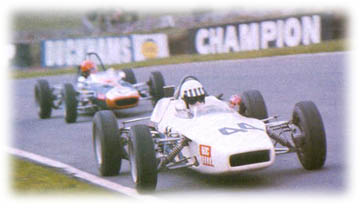 In 1956, Britain jumped the gun on the new 1500 cc Formula Two, which was scheduled to come into effect on New Year's Day of 1957. The first race run to the new formula was at Brands on August 6th, 1956, the "Bank Holiday Formula Two Race". The winner was Tony Brooks in a Rob Walker-entered Cooper 41-Climax. In 1956, Britain jumped the gun on the new 1500 cc Formula Two, which was scheduled to come into effect on New Year's Day of 1957. The first race run to the new formula was at Brands on August 6th, 1956, the "Bank Holiday Formula Two Race". The winner was Tony Brooks in a Rob Walker-entered Cooper 41-Climax.
The Formula One event held at Brands was the "V Silver City Trophy", the first major event using the new addition to the track, the "Grand Prix" circuit, which measured 4.265 km, doubling the size of the original circuit. The race was won, as were most that year, by Jack Brabham in a works Cooper 53-Climax.
In 1962, the British Grand Prix was held for the second consecutive year at Aintree. It was not a popular decision in many quarters, the track being highly unpopular. The race went back to Silverstone in 1963, but with the Brands track being easily more attractive in every sense over Aintree, the Royal Automobile Club (RAC) began to consider its options for 1964.
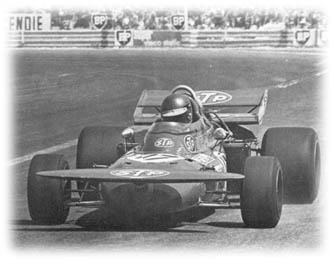 In 1964, rather than delegating the organisation of the Grand Prix to the BARC (British Automobile Racing Club) or the BRDC (British Racing Drivers Club), the RAC took matters into its own hands and took over the organisation of the race, with help from the BRSCC (British Racing and Sports Car Club). The RAC chose Brands Hatch to be the venue of the 1964 British Grand Prix. In 1964, rather than delegating the organisation of the Grand Prix to the BARC (British Automobile Racing Club) or the BRDC (British Racing Drivers Club), the RAC took matters into its own hands and took over the organisation of the race, with help from the BRSCC (British Racing and Sports Car Club). The RAC chose Brands Hatch to be the venue of the 1964 British Grand Prix.
The 1964 race saw two drivers at the top of their form, Jim Clark and Graham Hill, engage in a race long battle for the win. After 80 laps and over 2 hours and 15 minutes of racing, Clark's Lotus was less than 3 seconds ahead of Hill's BRM. It was an exciting race and an amazing performance by the two drivers. It was also Clark's third straight win of the Grand Prix on the third different course.
In 1965, the circuit held the first running of the Race of Champions, what was to become one of the premier non-Championship races. It attracted an excellent field of all the top flight teams and the private entrants.
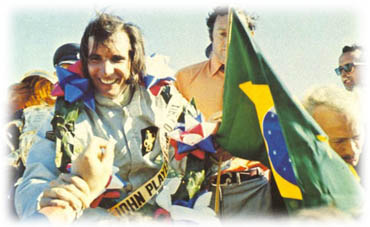 The race was run in two heats. In the first heat, Clark's Lotus was even headed with Dan Gurney, Brabham-Climax, leading Clark's teammate, Mike Spence, across the line. In the second heat, all the big stars ran into problems - Clark crashed, a rarity - and a surprised Mike Spence was first, followed by Joakin Bonnier in the Rob Walker Brabham-Climax, with Frank Gardner third in the John Willment Brabham-BRM. The race was run in two heats. In the first heat, Clark's Lotus was even headed with Dan Gurney, Brabham-Climax, leading Clark's teammate, Mike Spence, across the line. In the second heat, all the big stars ran into problems - Clark crashed, a rarity - and a surprised Mike Spence was first, followed by Joakin Bonnier in the Rob Walker Brabham-Climax, with Frank Gardner third in the John Willment Brabham-BRM.
In 1966, it was the first year of the 3-litre formula and Jack Brabham seemed to be better prepared than most and won the previous, the French Grand Prix at Rheims. It was the first victory in Championship event by a constructor in his own car. Brabham and Denis Hulme completely dominated the the entire race meeting. Brabham took the pole with Hulme next, and a surprising Dan Gurney, in his Eagle-Climax, third on the grid, the outside front row position. However, when the flag dropped, any racing was for no higher than third. The teammates lapped the field.
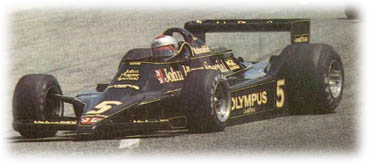 The 1968 race was missing the presence of the previous year's winner, Jim Clark - the five-time winner of the Grand Prix died in an accident during a Formula Two race at the Hockenheim. Graham Hill had stepped his game and taken charge of a team in shock. He won the Spanish and Monaco races and single-handedly pulled Team Lotus from the depths of despair. Hope for a win in the Grand Prix at last seemed very good when Hill won the pole. Next to him was new Team Lotus teammate, Jackie Oliver. But, it was not to be. Hill retired with a broken univeral joint while in the lead. Jackie Oliver assumed the lead and was enjoying a comfortable lead when the gearbox broke. The surprise winner was Josef Siffert in the Rob Walker-Jack Durlacher Lotus 49-Ford. It was the last victory for a true private entrant in a World Championship event. The 1968 race was missing the presence of the previous year's winner, Jim Clark - the five-time winner of the Grand Prix died in an accident during a Formula Two race at the Hockenheim. Graham Hill had stepped his game and taken charge of a team in shock. He won the Spanish and Monaco races and single-handedly pulled Team Lotus from the depths of despair. Hope for a win in the Grand Prix at last seemed very good when Hill won the pole. Next to him was new Team Lotus teammate, Jackie Oliver. But, it was not to be. Hill retired with a broken univeral joint while in the lead. Jackie Oliver assumed the lead and was enjoying a comfortable lead when the gearbox broke. The surprise winner was Josef Siffert in the Rob Walker-Jack Durlacher Lotus 49-Ford. It was the last victory for a true private entrant in a World Championship event.
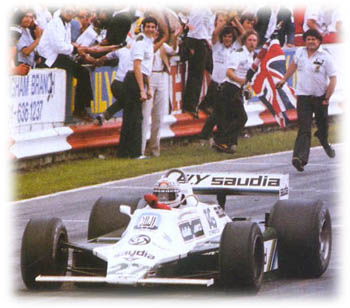 The next Grand Prix at Brands Hatch was decided in dramatic fashion. Jack Brabham was comfortably leading in his BT33, when he ran out of fuel just 200 meters short of completing the final lap. As had happened two months earlier in Monaco, Lotus driver Jochen Rindt thankfully cruised past Black Jack to claim victory. The race also saw a young talent making his debut; in an unremarkable race, Rindt's teammate Emerson Fittipaldi started his Formula One career. The next Grand Prix at Brands Hatch was decided in dramatic fashion. Jack Brabham was comfortably leading in his BT33, when he ran out of fuel just 200 meters short of completing the final lap. As had happened two months earlier in Monaco, Lotus driver Jochen Rindt thankfully cruised past Black Jack to claim victory. The race also saw a young talent making his debut; in an unremarkable race, Rindt's teammate Emerson Fittipaldi started his Formula One career.
When Formula One returned to Brands Hatch two years later, Fittipaldi had developed his talent fully and was a serious contender for the title. The race was as exciting as it could get, with Ferrari driver Jacky Ickx fending of Jackie Stewart (Tyrrell) and Fittipaldi (Lotus) time and time again. However, after 48 laps, Ickx' car suffered an oil leak and the Belgian had to abandon his quest for a Ferrari victory. When the chequered flag dropped, Fittipaldi assured his lead in the championship by winning before Stewart.
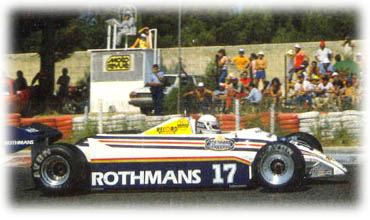 In the year in which Emerson Fittipaldi grew from rookie to winner, the French Grand Prix had moved from Clermont-Ferrand to the new Le Castellet track in the south of the country. With the extremely long Mistral straight, it was beforehand believed that Ferrari would be able to break Tyrrell's dominance of the season. In the end, Jackie Stewart proved everyone wrong, by taking a solid victory. Not the least to thank was the Tyrrell's innovating nose-section. With the full width nose, the car gained much downforce, allowing Stewart to make sure in the cornery sections that the Ferrari's were never close enough to strike on the long straight. In the year in which Emerson Fittipaldi grew from rookie to winner, the French Grand Prix had moved from Clermont-Ferrand to the new Le Castellet track in the south of the country. With the extremely long Mistral straight, it was beforehand believed that Ferrari would be able to break Tyrrell's dominance of the season. In the end, Jackie Stewart proved everyone wrong, by taking a solid victory. Not the least to thank was the Tyrrell's innovating nose-section. With the full width nose, the car gained much downforce, allowing Stewart to make sure in the cornery sections that the Ferrari's were never close enough to strike on the long straight.
The 1976 British Grand Prix took over two months to get a winner. After a start-line collision, caused by Ferrari drivers Clay Reggazoni and Niki Lauda, the race was stopped and later restarted. James Hunt raced to victory in his McLaren, only to see his win taken away later. According to the FIA, the Englishman hadn't been running when the race was first red flagged. After two months and six days, Niki Lauda was declared the winner of the race.
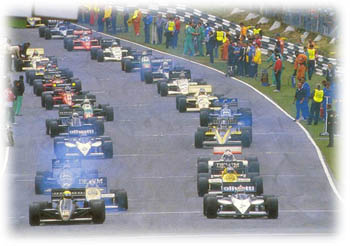 After many uneventful races on both Brands Hatch and Le Castellet, the 1985 race in France is one to mention. The race marked the end of an era, since it was the first race in which all cars were powered by 1.5 litre turbo engines. After a transition period, Tyrrell was the last team to switch from the long time used 3 litre normally aspired engines to the turbo engine. However, the turbo did not bring Tyrrell great success. The man of the day was Brabham pilot Nelson Piquet. The Brazilian won in the early summer heat, giving Italian tyre manufacturer Pirelli its first win since 1957. After many uneventful races on both Brands Hatch and Le Castellet, the 1985 race in France is one to mention. The race marked the end of an era, since it was the first race in which all cars were powered by 1.5 litre turbo engines. After a transition period, Tyrrell was the last team to switch from the long time used 3 litre normally aspired engines to the turbo engine. However, the turbo did not bring Tyrrell great success. The man of the day was Brabham pilot Nelson Piquet. The Brazilian won in the early summer heat, giving Italian tyre manufacturer Pirelli its first win since 1957.
The next year tragedy struck on the southern France track. During testing, Brabham driver Elio de Angelis lost his rear-wing at high speed. Subsequently, the Italian was launched into the air and landed some 200 meters further, on the other side of the track barriers. The Brabham, with its driver still in it, immediately caught fire. The ill-equipped track-side marshals then took a long time to extinguish the burning Brabham and after that, it also took too long for the helicopter to arrive and take de Angelis to the hospital in Marseilles. Thirty hours later, Elio de Angelis died in hospital.
Following the accident, the track was shortened by almost 2 kilometres even before that year's French Grand Prix took place. When the race took place, almost another major accident happened when Michele Alboreto's Arrows stopped working on the grid. Alboreto's signals were not seen and the race was started. The Italian was very fortunate to not be hit by anyone.
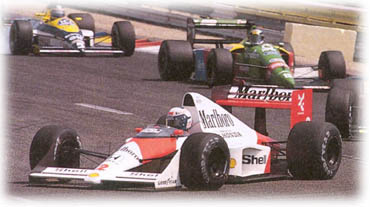 Two weeks later, in Brands Hatch, French veteran Jacques Lafitte was less fortunate. Going into the first corner, Arrows driver Thierry Boutsen triggered a multiple car pile-up in which Lafitte was caught. The rescue marshals needed half an hour to free the Frenchman from his wreck. He was taken to hospital with severe leg injuries, ending his Formula One career after 178 starts, with which he has equalled record holder Graham Hill. The race also ended Brands Hatch's string of Formula One races. The track was taken off the calendar, in favour of Silverstone. Two weeks later, in Brands Hatch, French veteran Jacques Lafitte was less fortunate. Going into the first corner, Arrows driver Thierry Boutsen triggered a multiple car pile-up in which Lafitte was caught. The rescue marshals needed half an hour to free the Frenchman from his wreck. He was taken to hospital with severe leg injuries, ending his Formula One career after 178 starts, with which he has equalled record holder Graham Hill. The race also ended Brands Hatch's string of Formula One races. The track was taken off the calendar, in favour of Silverstone.
Three years later, Le Castellet suffered another blow, when Brazilian March driver Mauricio Gugelmin somersaulted over the pack in the first corner. The race was immediately stopped and miraculously Gugelmin emerged from what was left of his car without a scratch. Even more amazingly, he walked away, stepped into the spare car and took part in the restart, putting in the fastest lap of the race. It was also in this race that a young F3000 driver made his stunning debut for Tyrrell - Jean Alesi held second place for a while and finished fourth in his first race.
In 1990, Le Castellet had its final Formula One race. The race was lead by March driver Ivan Capelli for a long time. The Italian hadn't made any pitstops to change tyres and almost got away with it. Sadly for March and Capelli, Alain Prost pushed more and more during the final stages of the race, eventually making Capelli destroy his tyres and taking Ferrari's 100th Grand Prix victory.
|









